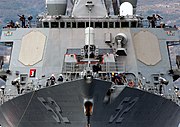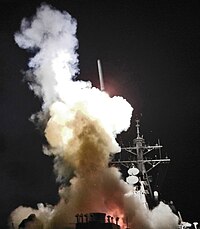| USS Barry (DDG-52) | |
|---|---|
 | |
| Career | |
| Name: | USS Barry |
| Namesake: | Commodore John Barry |
| Ordered: | 26 May 1987 |
| Builder: | Ingalls Shipbuilding |
| Laid down: | 26 February 1990 |
| Launched: | 10 May 1991 |
| Christened: | 8 June 1991 |
| Commissioned: | 12 December 1992 |
| Homeport: | Norfolk, Virginia |
| Motto: | Strength and Diversity |
| Status: | in active service, as of 2024[update] |
| Badge: |
 |
| General characteristics | |
| Class & type: | Arleigh Burke-class destroyer |
| Displacement: |
|
| Length: | 505 ft (154 m) |
| Beam: | 66 ft (20 m) |
| Draft: | 31 ft (9.4 m) |
| Propulsion: | 4 General Electric LM2500-30 gas turbines, two shafts, 100,000 total shaft horsepower (75 MW) |
| Speed: | >30 knots (56 km/h) |
| Range: |
|
| Complement: |
|
| Sensors and processing systems: |
|
| Electronic warfare & decoys: |
|
| Armament: |
|
| Aircraft carried: | 2 Sikorsky MH-60R helicopters can be embarked |

USS Barry (DDG-52) bow view.
USS Barry (DDG-52) is an Arleigh Burke-class guided missile destroyer, commissioned in 1992. Barry is the fourth United States Navy ship named after the "Father of the American Navy", Commodore John Barry (1745–1803). Its homeport is Naval Station Norfolk, Virginia. Several improvements over Arleigh Burke exist on this ship and all following Arleigh Burke-class destroyers. They include the ability to refuel a helicopter and several other small improvements.
Barry has received many awards, including the Battenberg Cup for the years 1994, 1996, and 1998—making Barry one of only three ships (as of 2008) to have won the prestigious award three times, and the only Aegis destroyer to have won the award thus far—earning her the nickname "Battenberg Barry" in the late 1990s. She has also been awarded the Battle E award 4 times, and received the Golden Anchor and Silver Anchor Awards for retention. More recently, in 2004 the Barry received the Arleigh Burke Fleet Trophy for being the most improved ship in the Atlantic Fleet.
History[]

The Barry firing a Tomahawk missile during Operation Odyssey Dawn on 19 March 2011
Barry's keel was laid down on 26 February 1990 at the Ingalls Shipbuilding shipyard in Pascagoula, Mississippi. She was launched on 10 May 1991, and christened on 8 June 1991 by her sponsor, Rose Cochran, wife of United States Senator Thad Cochran. Barry was commissioned into the U.S. Atlantic Fleet on 12 December 1992 and was placed under the command of Commander Gary Roughead. The commissioning ceremony took place at Naval Station Pascagoula in Mississippi.
Following ship's commissioning, Barry underwent Post Delivery Test and Trials (PDT&T). During this period, Barry tested every major system on board. An Operational Propulsion Plant Examination (OPPE) was conducted, with Barry receiving an overall grade of Excellent. Combat Systems Ship Qualifications Trials (CSSQT) were also conducted that included 13 missile firings.
In April 1993, Barry underwent Final Contract Trials (FCT) before returning to Ingalls Shipbuilding in May 1993 for a three-month Post Shakedown Availability (PSA). This availability included a 4-week dry-docking that included installation of the Navy's new generation Advanced Technology Design propellers, designed to reduce cavitation at high speed and improve fuel economy. Other improvements included installation of an Electro-Optical Sighting System (EOSS), application of Passive Countermeasure System (PCMS) material, tank stiffening and installation of a gray water collection system.
On 21 October 1993, Captain Gary Roughead, Barry's first commanding officer, was relieved by Commander James G. Stavridis. Barry was under command of (tactical) Destroyer Squadron 26 in 1993, 1994 and 1995, while administratively part of Destroyer Squadron 2. In November 1993, Barry received orders to proceed to Haiti to take part in Operation Support Democracy. Barry's duties included enforcing the embargo of arms and petroleum products to the island nation.
1994[]
In January 1994, Barry completed her first combined Combat Systems Assessment (CSA)/Cruise Missile Tactical Qualification (CMTQ), achieving one of the Atlantic Fleet's highest score to date. In March, Barry participated in exercise MAYFLYEX 94 where her Aegis combat system successfully engaged and destroyed several Exocet anti-ship cruise missiles. In April, Barry wrapped up her preparations for her first overseas combat deployment by participating in FLEETEX 2–94 with other units of the George Washington Battle Group. A highlight of this exercise was a covert SEAL team extraction in shallow water only a few miles off the Carolina coast, successfully validating the stealth characteristics of the DDG-51 class.
On 20 May 1994, Barry departed Norfolk, Virginia on her first Mediterranean deployment. During Barry's maiden deployment, she served alongside the USS George Washington as the backdrop for the 50th anniversary of D-Day. Barry also sailed the Mediterranean and Adriatic Seas as "Red Crown" in support of the No-Fly Zone over Bosnia-Herzegovina.
On 7 October 1994, Barry received orders to proceed to the Persian Gulf in response to Iraq's massing of troops on the Kuwaiti border. In what would become known as Operation Vigilant Warrior, Barry's participation included escort of both the George Washington and an amphibious assault group to anchorage off Kuwait City. Barry also served as alternate Persian Gulf Anti-Air Warfare Coordinator (AAWC), and principal Tomahawk strike platform during the crisis. Barry received a Meritorious Unit Commendation, the Southwest Asia Service Medal, the Armed Forces Service Medal, and the NATO Medal for her actions during the deployment and returned home to Norfolk, Virginia on 17 November 1994.
1995[]
In January 1995, Barry began a three-month SRA at Moon Engineering located in Portsmouth, Virginia. This SRA included the Women At Sea (WAS) modification.
2004[]
In March 2003 she was assigned to Destroyer Squadron 26.[1]
In 2004, Barry participated at the annual Fleet Week in New York City.
2006[]
In 2006, Barry joined USS Gonzalez (DDG-66) in providing cover for the Orient Queen, a cruise ship chartered by the United States to help evacuate American citizens during the 2006 Israeli-Lebanon conflict.[2]
2011[]
On 1 March 2011 Barry was dispatched to the Mediterranean Sea in response to the 2011 Libyan civil war. On 19 March 2011, the Navy reported that the Barry fired 55 Tomahawk cruise missiles to suppress the Libyan air defense system in support of United Nations Security Council Resolution 1973.[3][4] The official codename for the U.S. part of the operation is Operation Odyssey Dawn.[5] On 28 March, the Barry assisted a U.S. Navy P-3C Orion from Patrol Squadron Five and an A-10 Thunderbolt aircraft attacking a group of three Libyan Coast Guard boats which were firing upon merchant vessels.[6]
2013[]
In late August 2013 she was ordered, alongside her sister ships USS Gravely (DDG-107), USS Mahan (DDG-72) and USS Ramage (DDG-61) to patrol the eastern Mediterranean Sea in response to rising rumors of an imminent military intervention in the Syrian civil war.
References[]
- ↑ http://www.hazegray.org/worldnav/usa/surface.htm, Retrieved May 2012
- ↑ "U.S. sending help to evacuate Americans from Lebanon". CNN. 17 July 2006. http://www.cnn.com/2006/WORLD/meast/07/17/lebanon.evacuation/index.html. Retrieved 24 August 2010.
- ↑ Wilson, Todd Allen, "USS Enterprise Returns To Norfolk", Newport News Daily Press, 16 July 2011.
- ↑ "U.S. launches missile strikes against Libya". navy.mil. 19 March 2011. http://www.navy.mil/list_single.asp?id=98683. Retrieved 19 March 2011.
- ↑ "Operation Odyssey Dawn: U.S. Launches Military Strikes In Libya". The Huffington Post. 19 March 2011. http://www.huffingtonpost.com/2011/03/19/operation-odyssey-dawn-us_n_838009.html. Retrieved 19 March 2011.
- ↑ Ansarov (28 March 2011). "A-10s Tag Team with P-3s to Savage Libyan Coast Guard". defensetech.org. http://defensetech.org/2011/03/29/a-10s-tag-team-with-p-3s-to-savage-libyan-coast-guard/?wh=wh.
- This article includes information collected from the Naval Vessel Register, which, as a U.S. government publication, is in the public domain.
External links[]
| Wikimedia Commons has media related to USS Barry (DDG-52). |
- Official USS Barry Web site
- USS Barry (DDG 52) www.navysite.de (unofficial)[Clarification needed]
- USS Barry (DDG-52) Fred Willshaw. Destroyer Archive NavSource Naval History.
- USS Barry (DDG 52) 20 March 2007. Naval Vessel Register. NAVSEA Shipbuilding Support Office (NAVSHIPSO)
| ||||||||||||||
The original article can be found at USS Barry (DDG-52) and the edit history here.